| This article's lead section may be too long. Please read the length guidelines and help move details into the article's body. (August 2024) |

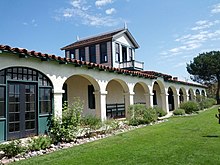
In Alta California (now known as California) and Baja California, ranchos were concessions and land grants made by the Spanish and Mexican governments from 1775 to 1846. The Spanish Concessions of land were made to retired soldiers as an inducement for them to settle in the frontier. These Concessions reverted to the Spanish crown upon the death of the recipient.
After independence, the Mexican government encouraged settlement in these areas by issuing much larger land grants to both native-born and naturalized Mexican citizens. The grants were usually two or more square leagues, or 35 square kilometres (14 sq mi) in size. Unlike Spanish Concessions, Mexican land grants provided permanent, unencumbered ownership rights. Most ranchos granted by Mexico were located along the California coast around San Francisco Bay, inland along the Sacramento River, and within the San Joaquin Valley.
When the government secularized the Mission churches in 1833, it required that land be set aside from their holdings for each Neophyte (or converted) Indian family who had been living at the missions. But the Native Americans were quickly brushed aside by Californios who, with the help of those in power, acquired the church lands as grants. The Indigenous peoples of the Americas ("Indians"), landless, became virtual slaves of the rancheros.
Spain made about 30 concessions between 1784 and 1821. Mexico issued about 270 land grants between 1833 and 1846. The ranchos established permanent land-use patterns. The rancho boundaries became the basis for California's land survey system, and are found on modern maps and land titles. The "rancheros" (rancho owners) patterned themselves after the landed gentry of New Spain, and were primarily devoted to raising cattle and sheep. Their workers included Native Americans who had learned Spanish while living and working at one of the former missions.
The ranchos were often based on access to resources necessary for raising cattle, such as water and adequate grazing lands and water. Land development from that time forward has often followed the boundaries of the ranchos, and many of their names are still in use. For example, Rancho San Diego is now an unincorporated "rural-burb" east of San Diego, and Rancho Bernardo is a suburb in San Diego.
Spanish era

Before 1754, only the Spanish Crown could grant lands in Alta California. For several years, the Franciscan missionaries were the only beneficiaries of this policy. Spanish laws allowed four square leagues of land (one league being approximately 4,428 acres (1,792 ha)) to be granted to newly-formed settlements, or pueblos.
Settlement on the ranchos outside presidio, mission, and pueblo boundaries began in 1784. Private individuals applied to the Governor for grants and he issued a few written temporary permits. The Spanish crown retained title. In 1784, Juan José Domínguez received permission from Spanish Governor Pedro Fages to graze his cattle on the 48,000-acre (190 km) Rancho San Pedro.
Two years later the governor received authority to grant tracts not exceeding three square leagues, as long as they did not conflict with the boundaries of existing pueblos. The grantee was required to build a stone house and to keep at least 2,000 head of stock on each rancho.
Mexican era
Further information: Mexican secularization act of 1833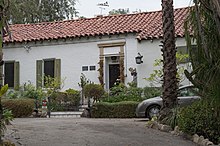
During the Mexican era (1821–1846), grantees received legal title to the land. In 1821, Mexico achieved its independence from Spain, and California came under control of the Mexican government. The 1824 Mexican Colony Law established rules for petitioning for land grants in California; and by 1828, the rules for establishing land grants were codified in the Mexican Reglamento (Regulation).
The Acts sought to break the land monopoly of the missions and also paved the way for luring additional settlers to California by making land grants easier to obtain. The Mexican governors of Alta California gained the power to grant state lands, and many of the Spanish concessions were subsequently patented under Mexican law—frequently to local "friends" of the governor.
Secularization
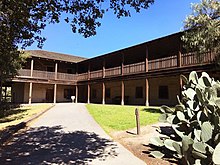
Soldiers, rancheros, farmers, and those in power coveted the rich coastal lands that the missions controlled. The Mexican government was also fearful about the missions which remained loyal to the Pope and the Catholic Church in Spain. In August 1833, the government secularized all of the missions and their valuable lands, about 1,000,000 acres (400,000 ha) per mission. The Mexican government allowed the padres to keep only the church, priest's quarters, and priest's garden. The army troops guarding each Mission were dismissed.
The government stipulated that one half the mission lands and property was to be given to neophytes in grants of 33 acres (13 ha) of arable land along with land "in common" sufficient "to pasture their stock." A board of magistrates was to oversee the mission's crops and herds, while the land was to be divided into communal pasture, a town plot, and individual plots intended for each Indian family. In addition, one half of the herds were to be divided proportionately among the neophyte families.
But this purpose was never accomplished. In truth, only a very few Indians of Alta California were educationally or culturally equipped to accept the offering. Instead, they were further exploited by the rancheros and in many cases became virtual slaves. Most mission property was bought by government officials or their wealthy friends, local Californios, individuals of Mexican or Spanish descent who had been born in Alta California.
Ownership
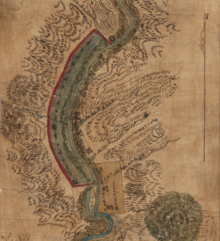
The number of Mexican land grants greatly increased after secularization. The former Mission Indians, freed from forced labor on the missions, but without land of their own, and their former way of life destroyed, often had few choices. Some lived with Indian tribes in the interior or sought work on the new ranchos along with the troops formerly assigned to each mission. They sometimes congregated at rancherías (living areas near a hacienda) where an indigenous Spanish and mestizo culture developed.
By 1846, the mission lands and its cattle had passed into the hands of 800 private landowners called rancheros. They collectively owned 8,000,000 acres (3,200,000 ha) of land, in units ranging in size from 4,500 acres (1,800 ha) to 50,000 acres (20,000 ha). They primarily produced hides for the world leather market and largely relied on Indian labor. Bound to the rancho by peonage, the Native Americans were treated as slaves. The Native Americans who worked on the ranchos died at twice the rate that of southern slaves.
The boundaries of the Mexican ranchos were provisional. The new owner was required to complete a legal survey that established and marked the boundaries. Even if completed, the resulting 'diseño', a rough, hand-drawn relief map, often only vaguely defined the boundary lines.
The grantee could not initially subdivide or rent the land. It had to be used for grazing or cultivation. A residence had to be built within a year—most were initially simple adobe-walled cabins. Public roads crossing through the property must remain open.
The survey and residence requirements could not be enforced. The poorly funded and relatively unorganized government had little interest in land that brought in no taxes. The government instead collected revenue from tariffs assessed on cargo arriving at Monterey, California.
American era

The Mexican–American War began on May 13, 1846 with a declaration of war by the United States of America. Action in California began with the taking of Monterey on July 7, 1846, Los Angeles in August, other battles in December, 1846, then retaking of Los Angeles in January, 1847, which terminated the authority and jurisdiction of Mexican officials later that year. Armed resistance ended in California with the Treaty of Cahuenga signed on January 13, 1847. The Treaty of Guadalupe Hidalgo, ending the Mexican War, was signed February 2, 1848 and California became a Territory of the United States. Between 1847 and 1849, California was run by the U.S. military. A constitutional convention met in Monterey in September 1849, and set up a state government. It operated for 10 months before California was admitted to the Union as the 31st State by the United States Congress, as part of the Compromise of 1850, enacted on September 9, 1850.
Gold Rush
While the end of the 1840s saw the close of Mexican control over Alta California, this period also marked the beginning of the rancheros' greatest prosperity. Cattle had been raised primarily for their hides and tallow, as there was no market for large quantities of beef, especially in the days prior to refrigeration, railroads or ice production. Demand dramatically changed with the onset of the Gold Rush, as thousands of miners and other fortune seekers flooded into northern California. These newcomers needed meat, and cattle prices soared with demand. The rancheros enjoyed the halcyon days of Hispanic California.
Land claims


The Treaty of Guadalupe Hidalgo provided that the Mexican land grants would be honored. To investigate and confirm titles in California, American officials acquired the provincial records of the Spanish and Mexican governments in Monterey.
The new state's leaders soon discovered that the Mexican government had given a number of grants just before the Americans gained control. The Mexican governors had rewarded faithful supporters, and hoped to prevent the new immigrants from gaining control of the land. Sponsored by California Senator William M. Gwin, in 1851 Congress passed "An Act to Ascertain and Settle Private Land Claims in the State of California". The Act required all holders of Spanish and Mexican land grants to present their titles for confirmation before the Board of California Land Commissioners. Contrary to the Treaty of Guadalupe Hidalgo, this Act placed the burden of proof of title on landholders. Grantees were required to prove the validity of the grants they had received and establish their exact boundaries. The diseños (maps) available were often hand-drawn and imprecise. Land had until the gold rush been of little value and boundary locations were often quite vague, referring to an oak tree, a cow skull on a pile of rocks, a creek, and in some cases a mountain range. The 588 grants made by Spanish and Mexican authorities in California between 1769 and 1846 encompassed more than 8,850,000 acres (3,580,000 ha), or nearly 14,000 square miles (36,000 km).
The settlement of land titles was frequently complicated and lengthy. Even in cases where the boundaries were more specific, many markers had been destroyed before accurate surveys could be made. Aside from indefinite survey lines, the Land Commission had to determine whether the grantees had fulfilled the requirements of the Mexican colonization laws. Mexican officials often did not keep adequate records and sometimes did not provide grantees with any documentation of the grant. Many grants required additional approvals before they were legal. Conditions of the grant required the grantee to live on the land. All of these requirements were rarely fulfilled.

While the Land Commission confirmed 604 of the 813 claims it reviewed, most decisions were appealed to US District Court and some to the Supreme Court. The confirmation process required lawyers, translators, and surveyors, and took an average of 17 years (including the Civil War, 1861–1865) to resolve. It proved expensive for landholders to defend their titles through the court system. In many cases, they had to sell or give title to a portion of their land to pay for defense fees or gave attorneys land in lieu of payment.
Rejected Spanish and Mexican land claims resulted in conflicting claims by the grantees, squatters, and settlers seeking the same land. This resulted in pressure on Congress to change the rules. Under the Preemption Act of 1841, squatters were able to pre-empt others' claims to portions of the land and acquire clear title by paying $1.25 an acre for up to a maximum of 160 acres (0.65 km). Land from titles rejected by the courts became part of the public domain and available to homesteaders after the first federal Homestead Act of 1862 was passed, allowing anyone to claim up to 160 acres (0.65 km). This resulted in additional pressure on Congress, and beginning with Rancho Suscol in 1863, it passed special acts that allowed certain claimants to pre-empt their land without regard to acreage. By 1866 this privilege was extended to all owners of rejected claims.
A number of ranchos remained in whole or in part in the sliver of territory of Alta California left to Mexico by the Treaty of Guadalupe Hidalgo, which then became part of Baja California. Rancho Tía Juana (partially in San Diego County, California) lost its claim to title to its land in San Diego County but the balance of the rancho was confirmed by the Mexican government in the 1880s. Rancho El Rosario, Rancho Cueros de Venado and Rancho Tecate were each granted to citizens of San Diego in the 1820s or 1830s and lay wholly in what is now Baja California as was the Rancho San Antonio Abad, whose origin and title is more obscure. Their titles were never subjected to dispute in U.S. courts.
Disintegration

The rancheros became land-rich and cash-poor, and the burden of attempting to defend their claims was often financially overwhelming. Grantees lost their lands as a result of mortgage default, payment of attorney fees, or payment of other personal debts. Land was also lost as a result of fraud. A sharp decline in cattle prices, the Great Flood of 1862, and droughts of 1863–1864 also forced many of the overextended rancheros to sell their properties to Americans. They often quickly subdivided the land and sold it to new settlers, who began farming individual plots.
A shift in the economic dominance of grain farming over cattle raising was marked by the passage of the California "No-Fence Law" of 1874. This repealed the Trespass Act of 1850, which had required farmers to protect their planted fields from free-ranging cattle. The repeal of the Trespass Act required that ranchers fence stock in, rather than farmers fencing cattle out. The ranchers were faced with either the high expense of fencing large grazing tracts or selling their cattle at ruinous prices.
Legacy
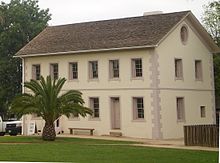
The ranchos established land-use patterns that are still recognizable in contemporary California. Many communities still retain their Spanish rancho name. For example, Rancho Peñasquitos, the first land grant by the Spanish in today's San Diego County, is now a suburb within the city of San Diego. Modern communities often follow the original boundaries of the rancho, based on geographic features and abstract straight lines. Today, most of the original rancho land grants have been dismantled and sold off to become suburbs and rural-burbs. A very small number of ranchos are still owned by descendants of the original owners, retain their original size, or remain undeveloped.
Rancho Guejito in San Diego County is considered the last of the San Diego Ranchos to be undeveloped. Only a few historic structures and an 8,000 square feet (740 m) ranch house, built in the 1970s, occupy the 13,300 acres (5,400 ha). Benjamin Coates purchased the land in the 1970s after Governor Jerry Brown vetoed a purchase that would have made Guejito a state park. Coates purchased an additional 8,700 acres (3,500 ha) of surrounding land between the 1970s and his death in 2004. Coates and his wife Nancy both expressed their wishes that the Rancho remain undeveloped. After her death in 2006, ownership of the land passed to their daughter, Theodate Coates, an artist from New York City. Despite her parents' wishes that development be kept off of the Rancho, she has taken steps to remove Rancho Guejito's status as an agricultural preserve and eventually develop the land into tract housing.
See also
- List of ranchos of California
- Spanish missions in California
- List of Spanish missions in California
- Land grants in New Mexico
- Bibliography of California history
- Outline of California history
Notes and references
- Cowan, Robert G. (1977) p. 4. "Ranchos of California" a list of Spanish Concessions 1775–1822 and Mexican Grants 1822–1846. Academy Library Guild, Fresno, California
- ^ "History of San Diego, 1542-1908". San Diego History Center | San Diego, CA | Our City, Our Story. Retrieved July 2, 2023.
- Robinson, William Wilcox (1979). Land in California. Ayer Co. ISBN 978-0-405-11352-9.
- ^ Blakely, Jim; Barnette, Karen (July 1985). Historical Overview: Los Padres National Forest (PDF). Archived (PDF) from the original on February 7, 2016. Retrieved September 6, 2016.
- ^ "How it all Started". Carmel Mission. Archived from the original on October 27, 2019. Retrieved May 16, 2018.
- ^ "Display Content Printable Version". digitalhistory.uh.edu. Archived from the original on March 27, 2016. Retrieved December 17, 2019.
- ^ "The Struggle Over Secularization of the Missions on the Alta California Frontier". Archived from the original on December 17, 2019. Retrieved December 17, 2019.
- "California Missions – Secularization Of The Missions". travel.yodelout.com. Archived from the original on May 25, 2017. Retrieved December 20, 2019.
- Davis, William Heath. (1929) Seventy-five Years in San Francisco – Missions and their Wealth; Hacendados and Their Property Archived 2008-12-07 at the Wayback Machine
- Cleland, Robert, 1975, The Cattle on a Thousand Hills: Southern California, 1850–1880, The Huntington Library, San Marino, CA.
- Coronel, Antonio, Edited by Doyce B. Nunis Jr. (1994) p.34-43. "Tales of Mexican California." Bellerophon Books
- Marti, Werner H. (1960) p. 87-107. "Messenger of Destiny, The California Adventures, 1846-1847 of Archibald H. Gillespie, U.S. Marine Corps." Published by John Howell-Books
- "More v. Steinbach, 127 U.S. 70 (1888)". Justia Law. Archived from the original on May 25, 2017. Retrieved December 20, 2019.
- "Monterey County Historical Society, Local History Pages--The California Cattle Boom, 1849-1862". mchsmuseum.com. Archived from the original on October 25, 2008. Retrieved July 30, 2009.
- Beck, Warren A. and Ynez D. Haase, Historical Atlas of California, first edition, p.24
- "Spanish and Mexican Land Grant Maps, 1855–1875" Archived 2012-01-08 at the Wayback Machine, California State Archives
- Paul W. Gates, 1971, The California Land Act of 1851, California Historical Society, Vol. 50, No. 4 (Dec., 1971), pp. 395–430
- "Ranchos of California" Archived 2009-02-02 at the Wayback Machine: Extracts from Cris Perez, Grants of Land in California Made by Spanish or Mexican Authorities
- "FEDERAL COURT RECORDS:Part 04". National Archives. August 15, 2016. Archived from the original on November 10, 2018. Retrieved June 4, 2018.
- "Dr. Hart's Mansion - Pacific Grove, California". hartmansion.com. Retrieved January 6, 2021.
- "Report of the Surveyor General 1844–1886" (PDF). Archived from the original (PDF) on March 20, 2013.
- "Finding Aid to the Documents Pertaining to the Adjudication of Private Land Claims in California, circa 1852-1892". Online Archive of California. Archived from the original on June 18, 2019. Retrieved December 20, 2019.
- "Ranchos and the Politics of Land Claims" (PDF). Archived from the original (PDF) on January 29, 2016. Retrieved May 27, 2010.
- Paul W. Gates, 2002, Land and Law in California: Essays on Land Policies, Purdue University Press, ISBN 978-1-55753-273-2
- Gordon Morris Bakken, 2000, Law in the western United States, University of Oklahoma Press, ISBN 978-0-8061-3215-0
- History of California, Volume 20 Archived 2016-01-20 at the Wayback Machine Hubert Howe Bancroft, Henry Lebbeus Oak, Frances Fuller Victor, William Nemos, History Company, Chicago, 1886, pp. 611-612 n.7
- Pitt, Leonard; Gutierrez, Ramon A. (1999). Decline of the Californios: A Social History of the Spanish-Speaking Californias, 1846–1890. University of California Press. ISBN 0-520-21958-9.
- Ludeke, John (1980). "The No Fence Law of 1874: Victory for San Joaquin Valley Farmers". California History. 59 (2): 98–115. doi:10.2307/25157972. JSTOR 25157972.
- "Decimation of the Herds, 1870–1912". San Diego History Journal. January 1965. Archived from the original on October 12, 2008. Retrieved July 30, 2009.
- David Hornbeck, "Land tenure and rancho expansion in Alta California, 1784–1846", Journal of Historical Geography, Volume 4, Issue 4, October 1978, pp. 371–390
Further reading
See also: Bibliography of California history- Avina, Rose H. (1976). Spanish and Mexican Land Grants in California, Arno Press, New York.
- Baker, Charles C. (1914). Mexican Land Grants in California, Historical Society of Southern California, Vol IX, pp. 236–243
- Beck, Warren A.; Ynez D. Haase (1974). Historical Atlas of California. University of Oklahoma Press. ISBN 0-8061-1212-3.
- Becker, Robert H. (1969). Designs on the land : disenos of California ranchos and their makers. San Francisco, Book Club of California.
- Beers, Henry Putney (1979). Spanish & Mexican records of the American Southwest : a bibliographical guide to archive and manuscript sources. University of Arizona Press, Tucson.
- Cowan, Robert G. (1956). Ranchos of California. Academy Library Guild, Fresno, Calif.
- Perez, Cris; California State Lands Commission. Grants of Land in California Made by Spanish Or Mexican Authorities (PDF). California State Lands Commission. Archived from the original (PDF) on May 25, 2017. Retrieved November 21, 2013.
- Perez, Crisostomo N. (1996). Land Grants in Alta California. Landmark Enterprises. ISBN 978-0-910845-55-7.
- Hayes, Derek (2007). Historical Atlas of California. University of California Press. ISBN 978-0-520-25258-5.
External links
- Spanish Archives of California (Archivo Español de California)
- Alameda County Mexican Land Grants
- Contra Costa County Mexican Land Grants
- Land Grants in Alta California
- Los Angeles County Spanish and Mexican ranchos Archived July 27, 2016, at the Wayback Machine
- Marin County Mexican Land Grants
- Marin County's Original Ranchos
- Monterey County Mexican Land Grants Archived 2009-02-19 at the Wayback Machine
- Napa County Mexican Land Grants
- Orange County Spanish and Mexican Ranchos
- San Benito County Mexican Land Grants
- San Francisco County Mexican Land Grants
- San Mateo County Mexican Land Grants Archived 2009-05-11 at the Wayback Machine
- Santa Barbara County Rancho Map
- Santa Clara County Mexican Land Grants
- Santa Clara Ranchos, Grants, Patents and Maps
- Santa Cruz CountyMexican Land Grants
- Sonoma County Mexican Land Grants
- Sonoma County Mexican Land Grants
- Tehama County Mexican Land Grants Archived February 26, 2012, at the Wayback Machine
- Ventura County Spanish and Mexican Land Grants